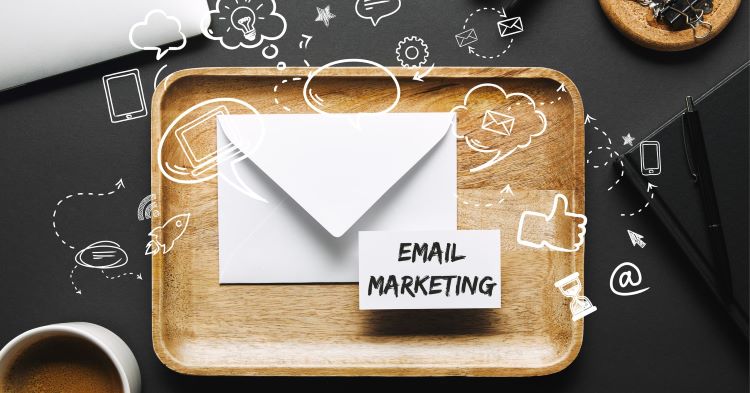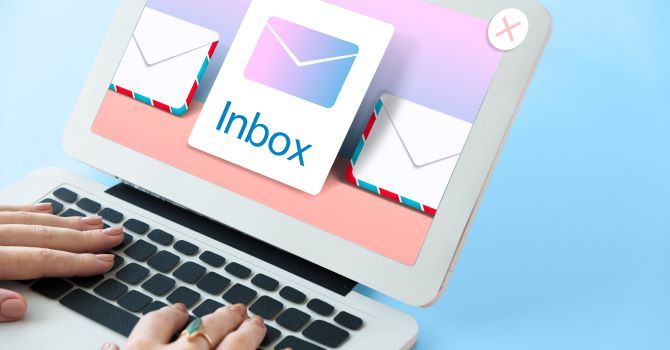Email Marketing for Authors: Why It’s Important and How to Do It
Marketing your book is not easy. As it happens, even experienced authors can also struggle with it. Fortunately, digital marketing has become more accessible than ever. Email marketing, specifically, has proven to be a powerful tool for authors to create genuine connections with their readers.
With email marketing, you can send out exclusive sneak peeks of your upcoming book to your subscribers, or share behind-the-scenes stories that your readers won’t find anywhere else.
But how does email marketing for authors work and how can you benefit from it to engage your followers? We will answer these questions, and more, in this article. We’ll also walk you through the steps of creating and maintaining a successful author newsletter.
In this article:
What Is Email Marketing for Authors?
To understand how emails function as a marketing tool, we need to talk about mailing lists first. Simply put, email marketing entails having an author mailing list, which is a list of contacts that you send emails to on a regular basis.
Think of it as a direct link between you and your fanbase. As you email them, you are actively communicating with them and encouraging them to reply to you as well. This way, you can use your mailing list as a way to easily market your future work as well as your author brand to your readers.
Why Do You Still Need an Author Mailing List in 2025?
Some people might think that mailing lists are an outdated marketing tactic when social media is so accessible. Nevertheless, email remains one of the best ways to reach out to thousands of people with personalized messages. It’s the middle ground between posting publicly on social media and sending private announcements to a closed community.
However, that’s not the only benefit you can gain from using email marketing! Below is a list of reasons why you should create a mailing list:
- Build direct relationships with readers: Email allows you to directly communicate with your readers. There are no middlemen or tricky algorithms standing in your way. Besides, about 88% of people check their emails daily. As a result, your emails can feel more personal, leading to stronger connections with your fanbase.
- Create a stable and reliable marketing channel: We’ve all witnessed the constant changes made to several social media platforms over the years. Contrarily, email doesn’t experience as many fundamental changes to its framework. Because of the importance of email in various aspects of life, most email services are highly stable and reliable.
- Propose sales pitches to an audience that’s more likely to accept them: Most of your subscribers will be fans of your work or looking to benefit from your expertise. Therefore, they are more likely to buy your books or pay for the products or services you offer.
- Encourage readers to give you helpful feedback: Sometimes, you will have valuable reading insights to gain from your subscribers. If you’re working on a different genre from your usual, for example, you can use your mailing list to ask readers for their opinions or feedback.
How to Create an Email List in 5 Steps
Now that you know the benefits you can gain from email marketing, it’s time to start working on creating and growing your email list. So, in this section, we will go over the essential steps of building one. We’ll cover how to choose the best email service providers for authors and how to optimize your content for your audience.
Step One: Choose an Email Service Provider
The first step of building a mailing list is choosing the right email service provider for your needs. There are quite a number of them available, but some are better than others. Besides, some providers charge higher prices in exchange for complicated features you may not need for your newsletter.
For these reasons, we did some research and found that most authors use these top budget-friendly tools:
- Mailerlite: Mailerlite offers a competitive free plan that suits many debut authors. It has a clean, intuitive interface, and a drag-and-drop feature that makes writing emails a smooth experience.
- ConvertKit: With its relatively new free plan, ConvertKit can now compete with the likes of Mailerlite in terms of value for money. In addition to standard email features like landing pages, this platform also allows you to run paid newsletters.
- ActiveCampaign: As a well-rounded email service, ActiveCampaign is best for authors who need dedicated tools like detailed analytics reports and prospecting ads for their business.
Let’s compare each provider’s pricing using their starter plans:
| Provider | <1,000 Subscribers | 1,000 to 2,500 Subscribers | 2,500+ Subscribers | 5,000+ Subscribers |
| Mailerlite | Free | $13.50/month | $22.50/month | $35.10/month |
| ConvertKit | Free* | $25/month | $41/month | $66/month |
| ActiveCampaign | $15/month | $15/month | $39/month | $79/month |
Also, keep in mind that the pricing plan you choose may have a limit on the volume of emails you can send per month. Still, you can always increase that limit by upgrading to a more expensive plan.
Step Two: Pick and Analyze Your Target Audience
After you subscribe to an email service, you must figure out how to find and convert your target audience to long-term fans. You can start by asking yourself some questions, such as:
- What sort of content or book genres have they expressed interest in?
- How did they, as readers, find your work in the first place?
- Do they enjoy sneak peeks or behind-the-scenes content?
Answering these questions will help you decide what content to write in your emails and which audiences will benefit most from it.
Moreover, you may find that you have more than one target audience. This usually happens if you write in several genres which may or may not be related. As such, you may have one audience for a book and a different one for another book. If you’re a non-fiction author, you may have one audience for your books, another for your courses and workshops, and yet another for your blog.
If you find yourself in that situation, then examine the types of books or services you offer and set up different subscriber segments accordingly.
Step Three: Decide What Kind of Content You Will Write
The next step is figuring out what sort of emails you will send to your subscribers. From your previous analysis, you can determine the best types of content to write and which segments of your audience to send them to.
There are many kinds of content you can write in your emails, such as:
- Book launch news
- Tips and advice about your niche
- Invitations or tickets to your events
- Lists of useful resources/tools for authors in your niche
- Exclusive behind-the-scenes content of your books
Step Four: Create a Schedule for Your Email Campaigns
Many writers agree that you should create a schedule to follow when sending your emails. Otherwise, sending them at random times may annoy your subscribers. Similarly, sending an email every two or more months might cause readers to forget about your newsletter.
Another important point is the volume of emails you send per month. While there aren’t any perfect numbers to follow, most authors will tell you to send no less than two emails per month and no more than two per week. However, you can always adjust that number as you analyze your engagement rates.
Step Five: Set Up Automatic Emails for New Subscribers
Before launching your newsletter, make sure to create an automatic email. That way, new subscribers will receive a “welcome” email that encourages them to look forward to your upcoming newsletters. You can also create automatic feedback emails after readers fill out a survey or participate in one of your webinars, for example.
Growing Your Mailing List Subscribers
Now that you’ve launched your newsletter, the next objective is to increase the number of your subscribers. After all, the purpose of your email list is to gain more active fans and readers to whom you can directly market your work.
Reaching Your First 500 Subscribers
Even if you ask everyone you know to subscribe to your newsletter, your subscriber count may not rise much. To further expand your list, you can start marketing your work to bring in new readers. So, here are a few recommendations to get you started:
- Establish your author presence online: To start, make sure to build an author website and set up your social media pages. You can also create paid ads that advertise your content on social media, participate in online forums like Quora, and attend events in your niche. By expanding your online reach, you can find new readers more easily, and hopefully, they will become newsletter subscribers as well to follow up with your work.
- Creating an author blog: You may also want to start your own author blog if you haven’t already. Doing so provides readers with helpful content they might like free of charge. In turn, they might subscribe to your newsletter so they stay updated whenever you post new articles.
- Create a reader magnet: A reader magnet is a free reward that readers receive after subscribing to your mailing list. It can be a downloadable checklist, an excerpt from one of your novels, or even a workbook. So, if you want to gain more subscribers, consider creating a reader magnet and add it to your blog, website, or social media channels. You can then ask your readers to subscribe to your newsletter in order to receive this item.
- Make your sign-up form accessible and use original, compelling copy: In order for readers to join your mailing list, you have to make your sign-up form as accessible as possible on your website. You can tell readers what types of emails you will be sending them on this form as well. On the form itself, you should also try to address readers using “you” rather than “they” so the copy feels personal to them. For instance, Jane Friedman tells you what you’ll receive once you subscribe to her newsletter.
- Revise your approach if needed: Be sure to analyze and monitor your email campaigns regularly so you become aware of any mistakes or room for improvement. For example, your current reader magnet idea can sound good on paper but may not attract enough readers. If that happens, try making some modifications such as changing its position on your website or even creating a different magnet entirely.
Beyond 500 Subscribers
Before you celebrate the growth of your subscriber list, keep in mind that you need to put even more effort into your newsletter from now on. After all, if you want to reap the benefits of having a newsletter, you need to keep existing subscribers engaged.
So, try out different ways to expand your author platform and gain more subscribers, such as:
- Guest-posting on popular blogs in your niche: Through guest-posting, you can reach wider audiences and allow other blogs to link back to your website at the same time.
- Hosting giveaways: You can use your other marketing platforms (such as your social media pages) to announce subscriber-only giveaways. Just make sure to properly explain every step of how to join the giveaway so participants know that joining the newsletter is one of the steps.
- Using old work or content as reader magnets: You can do this with one of your well-written books that doesn’t sell as well as it used to. That way, your reader magnet can help you gain even more subscribers and, by extension, more sales on your newer books.
- Attending conferences and events as a speaker, or hosting your own: By speaking at industry-relevant events, you are establishing your author presence in front of dozens of potential fans. Additionally, you can also form strong connections with readers and fellow writers alike, leading to more potential subscribers for your newsletter.
- Inviting other writers to do author swaps: During an author swap, you agree with another author to promote their book, reader magnet, or website in your newsletter. In exchange, the other author will promote your work in their newsletter as well.
Tips on Managing Your Author Newsletter’s Performance
Creating and maintaining a newsletter is not that difficult in itself. However, you need to work smart to make it successful. Sometimes, there might be unexpected challenges or “hidden catches” associated with maintaining a newsletter that may not be immediately obvious.
When maintaining your author mailing list, be aware of the following points:
- Implementing DMARC authentication: In response to spammers, Google and Yahoo! have made it a requirement for organizations to authenticate their email accounts using DMARC. As an author sending newsletters to a large audience, you must go through this step or else your email account will be flagged as spam.
- Reading your email service provider’s terms of use: Some email providers have strict rules about maximum bounce and unsubscribe rates. If you exceed those limits, your account may be suspended or even terminated, so be careful.
- Cleaning out your email subscribers list: Some authors may do this once a month, while others may do it a few times a year. Either way, we advise you to continually remove subscribers who don’t open or engage with your newsletter. Why? Because if they don’t open your emails at all, then you are wasting your monthly email quota on them. Worse yet, there’s a chance that they may mark your emails as spam if they forget who you are.

Photo by Cytonn Photography on Unsplash
Final Thoughts
By creating an author mailing list, you help guide more readers to your work and might be able to convert them to loyal fans. Better yet, these email lists are well-tested, easy to set up, and can help create more personal connections with your readers than most marketing channels do.
So, tell us what you think! Have you tried to create your own mailing list using any of the tips in this article? Share your experience with us in the comments below.
.
Read More
How to Become a Best-Selling Author: 5 Secrets for Success
The 4 Key Elements of a High-Conversion Book Landing Page
How to Create a Powerful Reader Magnet (10 Creative Ideas Included)




















hania
October 8, 2024Amazing article
Kotobee
October 31, 2024Thanks Hania